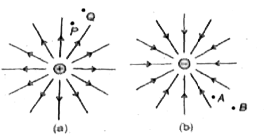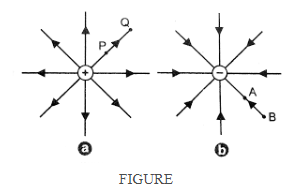The potential at a point A is – 500 V and that at another point B is + 500 V. What is the work done by external agent to take 2 units (S.I.) of negative charge from B to A.
The correct Answer is:WBA=2000J
To find the work done by an external agent to move a negative charge from point B to point A, we can follow these steps:
Step 1: Understand the given information
We have:
- Potential at point A, VA=−500V
- Potential at point B, VB=+500V
- Charge to be moved, Q=−2C (negative charge)
Step 2: Calculate the potential difference (ΔV)
The potential difference between points A and B is given by:
ΔV=VA−VB
Substituting the values:
ΔV=−500V−500V=−1000V
Step 3: Use the work done formula
The work done W by an external agent to move a charge in an electric field is given by:
W=Q⋅ΔV
Substituting the values of Q and ΔV:
W=(−2C)⋅(−1000V)=2000J
Step 4: Conclusion
The work done by the external agent to move the charge from point B to point A is:
W=2000J
We have:
- Potential at point A, VA=−500V
- Potential at point B, VB=+500V
- Charge to be moved, Q=−2C (negative charge)
The potential difference between points A and B is given by:
ΔV=VA−VB
Substituting the values:
ΔV=−500V−500V=−1000V
The work done W by an external agent to move a charge in an electric field is given by:
W=Q⋅ΔV
Substituting the values of Q and ΔV:
W=(−2C)⋅(−1000V)=2000J
The work done by the external agent to move the charge from point B to point A is:
W=2000J
Topper's Solved these Questions
- BOOK - CBSE COMPLEMENTARY MATERIALCHAPTER - ELECTROSTATICS AND CURRENT ELECTRICITY EXERCISE - SHORT ANSWER QUESTIONS (3 MARKS )23videos
ELECTROSTATICS AND CURRENT ELECTRICITY
- BOOK - CBSE COMPLEMENTARY MATERIALCHAPTER - ELECTROSTATICS AND CURRENT ELECTRICITY EXERCISE - LONG ANSWER QUESTIONS6videos
ELECTROSTATICS AND CURRENT ELECTRICITY
- BOOK - CBSE COMPLEMENTARY MATERIALCHAPTER - ELECTROSTATICS AND CURRENT ELECTRICITY EXERCISE - NUMERICALS49videos
ELECTROSTATICS AND CURRENT ELECTRICITY
- BOOK - CBSE COMPLEMENTARY MATERIALCHAPTER - ELECTRONIC DEVICES EXERCISE - NUMERICALS7videos
ELECTRONIC DEVICES
- BOOK - CBSE COMPLEMENTARY MATERIALCHAPTER - SAMPLE QUESTION PAPER 2019EXERCISE - Section C19videos
SAMPLE QUESTION PAPER 2019
Similar Questions
The electric potential at point A is 20V and at B is −40V. Find the work done by an external and electrostatic force in moving an electron slowly from B to A.
View SolutionFigure (a) and (b) show the field lines of a positive and negative point charge respectively.

(a) Give the signs of the potential difference . Vp−VQ,VB−VA
(b) Give the sign of the potential energy difference if a small negative charge is moved from points Q to P from point A to B.
(c) Give the sign of the work done by the field in moving a small positive charge from Q to P.
( d) Give the sign of the work done by the external agency in moving a samall negative charge from B to A .
(e ) Does the kinetic energy of a small negative charge increase or decrease in going from B to A ?View Solution
Knowledge Check
- Question 1 - Select One
The electric potential at. Point A is 20 V and B is – 20 . The work done by an external force in moving electron slowly from B to A is
A−6.4×10−18JB+6.4×10−18JC4×10−20JD−4×10−20J - Question 2 - Select One
The electric potential at point A is 1V and at another point B is 5V. A charge 3μC is released from B. What will be the kinetic energy of the charge as it passes through A?
A8×10−6JB12×10−6JC12×10−9JD4×10−6J - Question 3 - Select One
A charge Q is placed at the origin. The electric potential due to this charge at a given point in space is v. The work done by an external force in bringing another charge q from infinity up to the point is
AVqBVqCV+qDV
Figures (a) and (b) show the field lines of a positive and negative point charge respectively

(a) Give the signs of the potential difference VP−VQ,VB–VA.
(b) Give the sign of the potential energy difference of a small negative charge between the points Q and P, A and B.
(c) Give the sign of the work done by the field in moving a small positive charge from Q to P.
(d) Give the sign of the work done by the external agency in moving a small negative charge from B to A.
(e) Does the kinetic energy of a small negative charge increase or decrease in going from B to A?View SolutionWhich of the following statement(s) is/are correct? If the electric field due to a point charge varies as r^(-2.5) instead of r^(-2),then the Gauss law will still be valid. The Gauss law can be used to calculate the field distribution around an electric dipole. If he electric field between two point charges is zero somewhere,then the sign of the two charges is the same. The work done by the external force is moving a unit positive charge from point A at potential "V_(A)" to point B at potential "V_(B)" is,(V_(B)-V_(A))
View SolutionSome work is done to move a charge Q from infinity to a point A in space. The potential of the point A is given as V. What is the work done to move this charge from infinity in terms of Q and V?
View SolutionThe electrical potential at point in an electric field is 6 V. Find the work done in bringing 12 C of charge from infinity to that point.
View SolutionA charge is moved in an electric field of a fixed charge distribution from point A to another point B slowly. The work done by external agent in doing so is 100J . What is the change in potential energy of the charge as it moves from A to B ? What is the work done by the electric field of the charge distribution as the charge moves from A to B ?
View Solution

